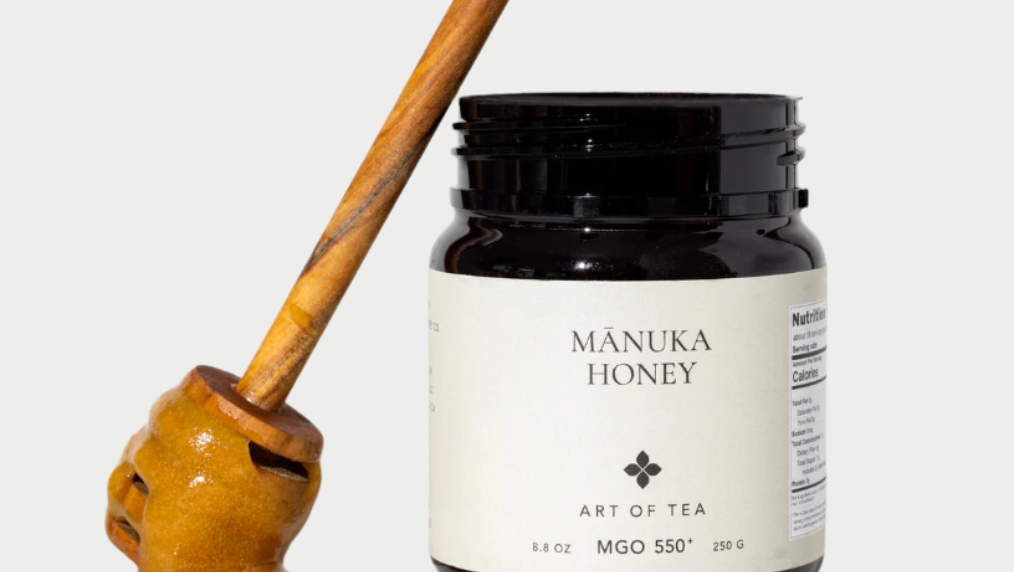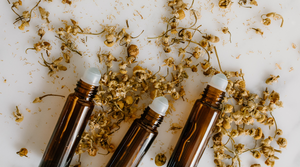Mānuka honey, derived from the Leptospermum scoparium tree native to New Zealand, is widely recognized for its powerful antibacterial, anti-inflammatory, and antioxidant properties. Unlike conventional honey, Mānuka honey contains high levels of methylglyoxal (MGO), a compound responsible for its unique therapeutic effects (Adams et al., 2008). Scientific studies support its use for wound healing, digestive health, oral care, and immune support, making it a staple for both dietary and topical applications.
This post contains affiliate links, which means I may earn a commission if you click through and make a purchase at no additional cost to you. As an affiliate of Art of Tea, I only recommend products I trust and believe will add value to my readers. Any earnings help support the content creation and maintenance of this website. Please note that the information provided in this article is for informational and educational purposes only and should not be considered medical advice. Always consult with a healthcare professional before making any dietary changes.

Antibacterial Properties
One of the most remarkable aspects of Mānuka honey is its ability to combat harmful bacteria. Research has demonstrated that Mānuka honey is effective against Staphylococcus aureus (MRSA) and other antibiotic-resistant bacteria, making it a potential alternative in antimicrobial therapy (Maddocks & Jenkins, 2013). The Unique Mānuka Factor (UMF) rating system measures the potency of MGO and other key compounds, ensuring that consumers select high-quality Mānuka honey with clinically relevant antibacterial activity (Kwakman et al., 2011).
Wound Healing and Skin Health
Mānuka honey has been extensively studied for its role in wound healing. Its low pH and high sugar content create an environment that inhibits bacterial growth while promoting tissue regeneration (Molan & Rhodes, 2015). Clinical trials have shown that Mānuka honey accelerates the healing of chronic wounds, burns, and ulcers (Carter et al., 2016). Furthermore, it provides natural hydration, making it beneficial for conditions like eczema and psoriasis.
Digestive Health Benefits
Consuming Mānuka honey may also support digestive health. Research indicates that Mānuka honey possesses activity against Helicobacter pylori, a bacterium associated with gastric ulcers (Alvarez-Suarez et al., 2010). Additionally, its anti-inflammatory properties may help alleviate symptoms of irritable bowel syndrome (IBS) by reducing gut inflammation and modulating gut microbiota (Shenoy et al., 2019).
Oral Health Applications
Maintaining oral hygiene is another key benefit of Mānuka honey. Studies suggest that its antibacterial properties can reduce harmful oral bacteria, including those responsible for plaque formation, gum inflammation, and tooth decay (English et al., 2004). Some research supports the use of Mānuka honey as a natural mouthwash to improve periodontal health (Jenkins et al., 2015).
Immune Support and Antioxidant Benefits
Mānuka honey contains a range of bioactive compounds that support the immune system. Its high levels of polyphenols and flavonoids help neutralize oxidative stress, potentially enhancing immune function (Estevinho et al., 2008). Regular consumption of Mānuka honey may serve as a complementary approach to strengthening the body's defenses against infections.
How to Use Mānuka Honey
To experience the benefits of Mānuka honey, consider incorporating it into your routine in the following ways:
- Topical Application: Apply a thin layer to minor cuts, burns, or irritated skin to promote healing and prevent infection.
- Oral Consumption: Take a spoonful daily, either directly or mixed into warm (not hot) beverages, to support digestive health and immune function.
- Oral Care: Use Mānuka honey as a natural mouthwash by diluting it with water or applying it to the gums to help reduce oral bacteria.
Adding Mānuka Honey to Tea: A Soothing and Health-Boosting Ritual

Mānuka honey is a perfect addition to tea, offering both a natural sweetener and a health-enhancing component. Whether you're looking to soothe a sore throat, support digestion, or boost your immune system, incorporating Mānuka honey into your tea routine can provide numerous benefits.
1. Retaining the Nutritional Benefits
One important factor to consider when adding Mānuka honey to tea is the temperature. Excessive heat can degrade some of the beneficial compounds, particularly methylglyoxal (MGO), the key antibacterial component of Mānuka honey (Chen et al., 2012). To preserve its health benefits, allow your tea to cool to around 104°F (40°C) before stirring in the honey.
2. Soothing the Throat and Reducing Cough
Mānuka honey is well-known for its throat-soothing properties. Research has shown that honey, including Mānuka honey, can be an effective natural remedy for sore throats and coughs, sometimes even outperforming conventional over-the-counter cough suppressants (Oduwole et al., 2018). Drinking warm tea with Mānuka honey can help coat the throat and provide relief from irritation.
3. Supporting Digestive Health
Tea varieties like ginger, peppermint, and chamomile have been used traditionally for digestive support. Adding Mānuka honey enhances these benefits due to its antimicrobial and anti-inflammatory properties. Studies suggest that Mānuka honey may help balance gut bacteria and aid in reducing symptoms of indigestion and acid reflux (Alvarez-Suarez et al., 2018).
4. Boosting Antioxidant Intake
Many teas, especially green and herbal varieties, are rich in antioxidants. Mānuka honey contains flavonoids and phenolic compounds that further contribute to antioxidant defense, helping to reduce oxidative stress and inflammation in the body (Molan, 2001).
How to Add Mānuka Honey to Your Tea for Maximum Benefits
- Choose a high-quality Mānuka honey with a UMF rating of 10+ or higher.
- Brew your tea as usual, then allow it to cool slightly to around 104°F (40°C) before adding the honey.
- Stir in 1 teaspoon of Mānuka honey gently to retain its nutritional benefits.
- Enjoy mindfully, savoring the natural flavors and health-boosting properties.
By making Mānuka honey a staple in your tea routine, you can harness its scientifically backed benefits while enjoying a delicious and comforting drink.
When selecting Mānuka honey, look for products with a UMF rating of 10 or higher, indicating a higher concentration of beneficial compounds. The Art of Tea's Mānuka honey, with an MGO rating of 550+, corresponds to approximately UMF 15+, exceeding this recommendation and ensuring a potent level of antibacterial and health-supporting properties. Always consult with a healthcare professional before starting any new health regimen, especially if you have underlying health conditions or are taking medications.
In summary, Mānuka honey stands out as a natural substance with a range of scientifically supported health benefits. Its unique properties make it a valuable addition to both your wellness and skincare routines.
References
-
Adams, C. J., Boult, C. H., Deadman, B. J., Farr, J. M., Grainger, M. N., Manley-Harris, M., & Snow, M. J. (2008). Isolation by HPLC and characterization of the bioactive fraction of New Zealand Mānuka (Leptospermum scoparium) honey. Carbohydrate Research, 343(4), 651-659. https://doi.org/10.1016/j.carres.2007.12.011
-
Alvarez-Suarez, J. M., Gasparrini, M., Forbes-Hernández, T. Y., Mazzoni, L., & Giampieri, F. (2018). The composition and biological activity of honey: A focus on Mānuka honey. Foods, 7(8), 109. https://doi.org/10.3390/foods7080109
-
Alvarez-Suarez, J. M., Tulipani, S., Romandini, S., Bertoli, E., & Battino, M. (2010). Contribution of honey in nutrition and human health: A review. Mediterranean Journal of Nutrition and Metabolism, 3(1), 15-23. https://doi.org/10.1007/s12349-009-0051-6
-
Carter, D. A., Blair, S. E., Cokcetin, N. N., Bouzo, D., Brooks, P., Schothorst, R. C., & Harry, E. J. (2016). Therapeutic Mānuka honey: No longer so alternative. Frontiers in Microbiology, 7, 569. https://doi.org/10.3389/fmicb.2016.00569
-
Chen, C., Campbell, L. T., Blair, S. E., & Carter, D. A. (2012). The effect of standard heat and filtration processing procedures on antimicrobial activity and hydrogen peroxide levels in honey. Frontiers in Microbiology, 3, 265. https://doi.org/10.3389/fmicb.2012.00265
-
Cokcetin, N. N., Pappalardo, M., Campbell, L. T., et al. (2016). The antibacterial activity of Australian Leptospermum honey correlates with methylglyoxal levels. PLOS ONE, 11(12), e0167780. https://doi.org/10.1371/journal.pone.0167780
-
English, H. K., Pack, A. R. C., & Molan, P. C. (2004). The effects of Mānuka honey on plaque and gingivitis: A pilot study. Journal of the International Academy of Periodontology, 6(2), 63-67.
-
Estevinho, L., Pereira, A. P., Moreira, L., Dias, L. G., & Pereira, E. (2008). Antioxidant and antimicrobial effects of phenolic compounds extracts of Northeast Portugal honey. Food and Chemical Toxicology, 46(12), 3774-3779. https://doi.org/10.1016/j.fct.2008.09.062
-
Henriques, A., Jenkins, R. E., & Burton, N. F. (2010). The intracellular effects of Mānuka honey on Staphylococcus aureus. European Journal of Clinical Microbiology & Infectious Diseases, 29(1), 45-50. https://doi.org/10.1007/s10096-009-0817-2
-
Jenkins, R., Burton, N., & Cooper, R. (2015). Proteomic and genomic evidence supports the role of Mānuka honey as a wound healing agent. Advances in Wound Care, 4(4), 291-302. https://doi.org/10.1089/wound.2014.0586
-
Kwakman, P. H., Te Velde, A. A., De Boer, L., Speijer, D., Vandenbroucke-Grauls, C. M., & Zaat, S. A. (2011). How honey kills bacteria. FASEB Journal, 25(7), 2702-2714. https://doi.org/10.1096/fj.10-165779
-
Maddocks, S. E., & Jenkins, R. E. (2013). Honey: A sweet solution to the growing problem of antimicrobial resistance? Future Microbiology, 8(11), 1419-1429. https://doi.org/10.2217/fmb.13.105
-
Majtan, J. (2011). Methylglyoxal—a potential risk factor of Mānuka honey in healing of diabetic ulcers. Evidence-Based Complementary and Alternative Medicine, 2011, 1-10. https://doi.org/10.1155/2011/295494
-
Molan, P. C. (2001). Why honey is effective as a medicine: I. Its use in modern medicine. Bee World, 82(1), 22-40. https://doi.org/10.1080/0005772X.2001.11099495
-
Molan, P. C., & Rhodes, T. (2015). Honey: A biologic wound dressing. Wounds, 27(6), 141-151.
-
Oduwole, O., Meremikwu, M. M., Oyo-Ita, A., & Udoh, E. E. (2018). Honey for acute cough in children. Cochrane Database of Systematic Reviews, 4(CD007094). https://doi.org/10.1002/14651858.CD007094.pub5
-
Shenoy, V. P., Patil, V., Kumar, N., & Shastry, B. A. (2019). Role of honey in gastrointestinal diseases: A comprehensive review. Journal of Research in Medical Sciences, 24, 68. https://doi.org/10.4103/jrms.JRMS_343_18



